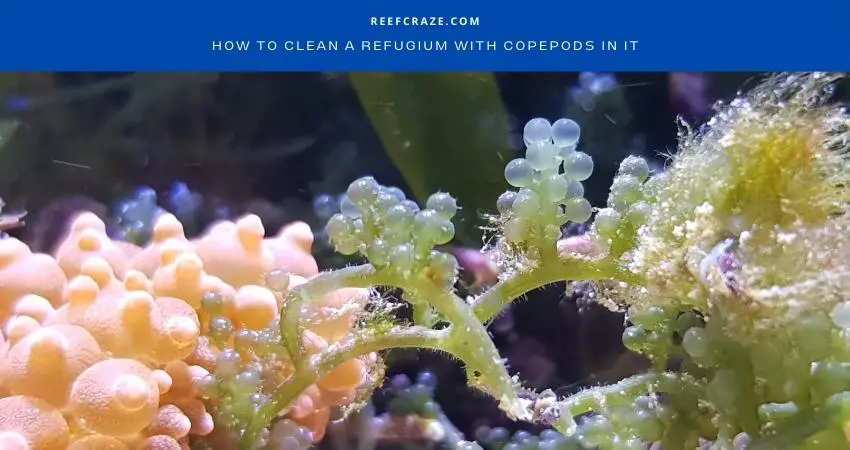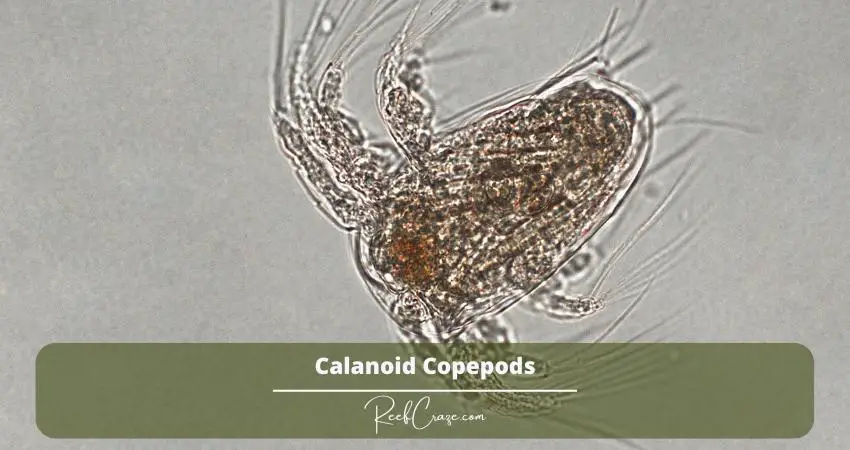Copepods are a natural cleaner for fish tanks. They feed on leftover fish food, algae or chaeto, and other tank matter as they feed on pretty much anything, keeping the tank water naturally clean. Nevertheless, cleaning the aquarium from time to time is essential to keep the environment healthier. But before that, you need to know how to clean a refugium with copepods in it.
You do not need to clean a refugium often as they are maintained naturally. But if necessary, you can just harvest the grown algae or chaeto, blocking the refugium space. Clean up the sides so you can keep an eye on what’s going on inside and at the bottom area of the refugium.
Cleaning a refugium is impossible without having the risk of removing copepods in the process. The good thing is cleaning a refugium is not a hassle, making it easy to maintain it without losing many copepods. I have discussed this topic more in this article.

How To Clean A Refugium With Copepods In It
Copepods are useful when you have a tank refugium. They benefit the tank by balancing nutrients level and reducing waste as they consume them as food. But pods are tiny tank water creatures that you cannot remove like you can remove fish when cleaning the tank.
So when it comes to cleaning the refugium, it is natural to worry about the issue. But how do you clean a refugium with copepods in it?
You cannot drain everything off the refugium if you want to keep the pods. But if you do not care about keeping them, you can take out everything and clean the entire refugium and its chambers with a cleaner. Then you can set up everything with substrate and media to seed refugium creatures.
However, it is not mandatory to clean a refugium with copepods like that because it takes some time for the pods and chaeto to grow. So the best thing to do is clean parts of the growing algae or chaeto to prevent nutrients from intoxicating the environment.
You can remove a mesh fabric to remove algae from the surface and the glass walls. As for chaeto, you need to culture them from time to time to keep the refugium clean without losing many copepods.
You can shake the cultured chaeto in your tank water to release the pods stuck in the chaeto. In this way, you can feed your aquarium fishes with copepods rather than wasting them. Cleaning the refugium like that will still leave you with enough pods and chaeto while you create more room for new ones to grow.
Additional Read: What do you feed copepods in a refugium
How To Clean A Refugium Without Losing Copepods
It is impossible to clean the refugium without losing copepods. Even if you try various tricks, you will still lose a significant quantity of them. The only way to prevent that is to hand pick them one by one to remove them from the refugium before you clean it. But that is another way of saying that the task is still impossible.
Many people avoid cleaning refugium for years because of this problem. If you do not want to lose the copepods, the best thing you can do is seed a new sponge if there is enough room left. But make sure to do it when the old one is still in there.

But this might still not guarantee that the pods will remain. You must let them go because the refugium and the display tank’s environment are more important than some pods. Once cleaned, you can add them gradually over time.
And instead of pouring the pods down your sink, you can make good use of them. When taking out chaeto and sponges, you can give them a little shake in the display tank’s water. It will help release the pods into the tank water, and the fishes and other aquarium creatures can feast on them.
Besides, in this way, you will have some copepods left in the aquarium. Sometimes, pods still remain in the gunk even when you clean it. So you can place it in again after cleaning the refugium and may still have some leftover copepods.
Refugium Clean-Up Crews
Many aquarists set up their refugium in a way so that they will not have to worry about cleaning it. Mind you, some of them go years without cleaning the refugium because they have added media and creatures that can clean the refugium naturally. Let’s call them the refugium clean-up crews.
So what are they? And how do they keep the refugium clean?
Generally, the clean-up crew is the creatures you keep in your refugium (also in main display tank) to help maintain the cleanliness. These creatures eat things like algae, chaeto, food and fish waste, and pests to help keep the nutrients level under control.
Having a clean-up crew also lowers your effort of cleaning the refugium often. Here is more on the refugium clean-up crew.
For Algae
Any well-illuminated environment will grow algae, that is for sure. But since a refugium is a small area, you would not want it to be covered by algae. It can grow everywhere in the refugium from all the stones. So you need something to keep them under control and prevent them from increasing the refugium’s nutrient level.
You can add some carnivore animals like snails to the refugium because they eat algae and keep them under control. But you would not want animals that are too fond of algae because you do not want them wiped out.
I would say it is best to get captive-bred snails if you want to prevent algae from intoxicating the refugium. This type of snail does not feast on algae but will eat enough to keep the refugium cleaner.
Additional Read: How to get rid of algae in a reef tank
For Detritus
POM or particulate organic matter can be set easily in areas where the water flow is low. While they are not bad for the refugium, these organic matters are handy to remove solid wastes from your display tank.
On top of that, you can keep the POM or detritus under control by adding copepods. By now, you already know that copepods eat algae and other organic matter. So when you have pods in the refugium, you will balance detritus by eating them when the detritus eats other wastes.
You can also add captive-bred snails here, as wild ones are not always helpful. They are also handy for controlling algae and cleaning the refugium.
For Pests
So many water “animals” are available to control the refugium pests. And many of them are excellent as permanent refugium inhabitants. The peppermint shrimp is one such example.
Peppermint shrimps do not just control pests. They are also known for being beneficial in managing waste in the refugium. And by that, I did not mean only tiny organic matters. Peppermint shrimps scavengers on larger chunks and cleans the refugium well enough.
It means that whatever the copepods eat in hours, peppermint shrimps can devour them in minutes. If you have snails in your refugium and it dies, you will notice that the shrimps are feasting on it before the poor guy even gets the chance to decay.
Frequently Asked Questions
How do I remove copepods from a refugium?
A siphon is the most effective way to remove copepods from a refugium. It makes the process quick and requires less hassle. Another way to remove pods is to shine a flashlight on an area of the refugium. Pods are highly attracted to light and will gather where you flash the light, making it easier to take them out.
What do copepods do in a refugium?
Copepods are one of the typical inhabitants of a refugium. They live and breed there over time, eating available waste, algae, and other food provided for them. Since fish and snails eat copepods, the refugium is a safer place for them to live without getting eaten while offering various benefits to the refugium setup.
How often should you clean the refugium?
Since the refugium is set up to provide a separate location for algae to grow, it naturally gets overloaded with algae and other contaminants. Unless you have clean-up crews in there, it is essential to clean the refugium once every two months or earlier if necessary.
Are copepods safe for fish to eat?
Yes, copepods are safe and cause no harm if fish eat them. In fact, copepods are a natural food source for fish and snails and benefit them in many ways.
Do copepods need air?
The copepods need good airflow to stay healthy and happy. You can set up an air pump and adjust the flow to ensure it is neither too high nor low for the copepods.
Final Words
Just as some people do not worry about losing their refugium pods, some prefer not to lose them in the cleaning process. That is why it is best if you know how to clean a refugium with copepods in it.
With copepods already helping with keeping the tank clean enough, you only need to culture the chaeto and remove algae from time to time. You can also add more clean-up crews to make the job hassle-free.

